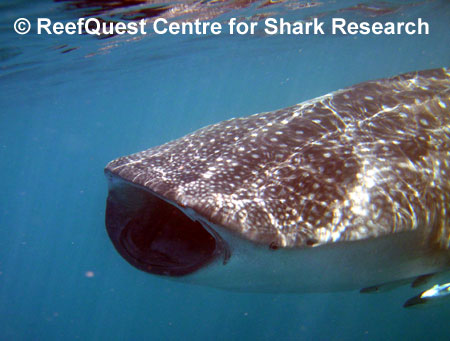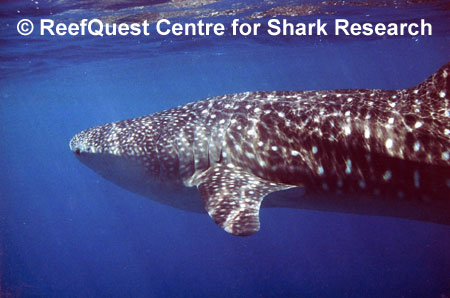Coral Reefs: Diversity on Display
Whale Shark
The gigantic, polka-dotted Whale Shark (Rhincodon typus) is the largest living fish. Exactly how large Whale Sharks can grow is a subject of intense fascination and debate. Reports of individuals estimated to be as long as 60 feet (18 metres) persist, although the largest actually measured was about 45 feet (13.7 metres) long — and the largest recently measured and reported in the scientific literature was 39 feet 8.5 inches (12.1 metres) long.
Just the Facts:
Size:
Reproduction:
Diet:
Habitat: Intertidal, Rocky Reefs, Coral Reefs, Open Ocean, Deep Sea Depth: Usually encountered at or near the surface, to at least 985 ft (300 m) Distribution: Central Pacific, Tropical Eastern Pacific, Chilean, Western North Atlantic, Caribbean, Amazonian, West African, Southern African, Central South Indian, Madagascaran, Arabian, Indian, South East Asian, Western Australian, Southeast Australian/New Zealand, Northern Australian, Japanese |
Even a ‘mere’ 45-foot (12-metre) Whale Shark is an awfully BIG fish — such a shark has a mouth almost 6 feet (2 metres) across, gill slits over 5 feet (1.5 metres) in length, pectoral fins 8 feet (2.4 metres) long, a maximum girth of about 22 feet (6.7 metres), a first dorsal fin about four feet (1.2 metres) tall, a caudal fin spanning some 16 feet (4.8 metres) and a total mass of about 13 tons (12 tonnes). But these mere numbers cannot convey the sheer enormity of these animals. Until one experiences being in the water next to a free-swimming Whale Shark, such figures are meaningless and without implication.
Despite their great size, Whale Sharks have tiny teeth and feed largely on plankton. It may seem strange that the largest shark in the sea feeds on some of its smallest creatures. But feeding on tiny, super-abundant prey is highly advantageous from an energetic standpoint. Such planktonic animals — termed “zooplankton” — occupy a trophic (feeding) position near the base of the food web, where most of the sun’s radiant energy remains trapped within their tiny bodies. Because animals are inefficient at converting calories into tissues, roughly 90% of the energy available at a given trophic level is lost to each subsequent level. An upper-level carnivore — such as the Shortfin Mako (Isurus oxyrinchus) — is removed from the tiny, planktonic photosynthesizers at the base of the epipelagic food web by four or five trophic levels. In comparison, the Whale Shark feeds primarily one or two trophic levels above the phytoplankton. Thus, only one thousandth or ten thousandth as much energy is available at the trophic level of the Shortfin Mako as is available to the Whale Shark at its trophic level. It is no coincidence that the very largest whales feed almost exclusively on zooplankton, occupying a trophic level that broadly overlaps that of the Whale Shark.
Unlike filter-feeding whales, however, the Whale Shark is not dependent upon zooplankton as food. In addition to tiny planktonic crustaceans such as krill, crab larvae, and copepods, the Whale Shark’s diet includes larger, nektonic prey, such as small schooling fishes, squids, mackerels, and even small tunas. There are also reports of phytoplankton, algae, and kelps among Whale Shark stomach contents. Thus, it is a gross oversimplification to categorize Whale Sharks as ‘planktivores’, for they feed on a wide variety of organisms — from plants and tiny drifters to surprisingly large, powerful swimmers.
The Whale Shark owes part of its dietary diversity to its feeding structures. It possesses virtually no snout and very broad, frog-like jaws, making the front of the animal ‘all mouth’. The teeth are tiny but very numerous — each only about 1/8 of an inch (3 millimetres) tall, numbering roughly 27,000 arranged in some 300 rows — and do not seem to function in feeding. Instead, the Whale Shark relies on a filtering mechanism consisting of angular, spongy plates that bridge the gaps between successive gill bars (the cartilaginous skeletal structures that support the gills). Perhaps most importantly, the Whale Shark — like its close relative the Nurse Shark (Ginglymostoma cirratum) — possesses very thick, powerful throat and gill muscles.

All these features combine to make the Whale Shark an extremely versatile suction-feeder, using its bellows-like throat and gill muscles to pump food-bearing water over its spongy filter plates. This ability frees Whale Sharks from relying on their own forward movement to push food-bearing water into the mouth and over their filtering mechanism. This freedom may be an important adaptation to the relatively nutrient-poor tropical seas typically inhabited by Whale Sharks, as these waters support plankton that is smaller and more widely scattered than that at higher latitudes.
The Whale Shark’s varied diet is also a consequence of its feeding behavior. No mere simple ram filter-feeder, this species often assumes a vertical feeding posture with its mouth uppermost near the surface and actively ‘pumps’ its body up-and-down in the water column. Each pumping cycle lasts 15 to 20 seconds, with the shark pausing at the surface each cycle to allow food-bearing water to rush into its mouth and strain through the spongy gill plates. Because oceanic plankton often occurs in concentrated patches, this feeding strategy enables the Whale Shark to remain in an area of rich feeding and to take advantage of induced water movements to increase the efficiency of its filter feeding mechanism.
There are numerous reports of associations between Whale Sharks and tunas. These large pelagic fishes feed on smaller schooling fishes that often congregate to feed on the same plankton-rich patches that lure Whale Sharks. It is unknown how Whale Sharks locate patches of concentrated plankton in the vast expanse of the open ocean. They may use scent, cueing on a chemical released during zooplankton feeding called dimethyl sulfide (DMS). Or Whale Sharks may cue on the violent, splashing commotion created by feeding tunas. This strategy would enable these sharks to take advantage of the expanded sensory capabilities of entire schools of tunas — using them in a manner analogous to a truffle farmer employing a sensitive-snouted pig. However Whale Sharks find plankton patches, their relationship with tunas goes far beyond mere association. One researcher reported seeing several tuna appear to leap into the mouth of a vertically feeding Whale Shark at the conclusion of each ‘pump’ cycle. If Whale Sharks actually swallow the tunas and other large fishes they suck in — accidentally or otherwise — they certainly must add considerably to the sharks’ protein intake.
Feeding success is strongly correlated with reproductive success in many animals. Until very recently, however, we knew virtually nothing about reproduction in Whale Sharks. We didn’t even know whether this species lays eggs or gives birth to live young. In 1955, a large eggcase measuring 12 inches (30 centimetres) long, 5.5 inches (14 centimetres) wide and 3.5 inches (9 inches) thick was dredged up from a depth of 185 feet (57 metres) in the northern Gulf of Mexico. When opened, it was found to contain a nearly full-term Whale Shark fetus, 14 inches (39 centimetres) long. Based on this, it was assumed that the species is oviparous. However, this assumption has been questioned due to extreme thinness of the case, its lack of tendrils (which in most egg-laying sharks are used to attach eggcases to the substrate), the considerable quantity of yolk, the partially developed filter plates, and the presence of a vitelline (‘umbilical’) scar on considerably larger free-swimming specimens. Speculation abounded that this eggcase may have been prematurely aborted. But the mystery surrounding Whale Shark parturition remained impenetrable for 40 years.
In July 1995, a 35-foot (10.8-metre) female Whale Shark estimated to have weighed 35,000 pounds (16,000 kilograms) was harpooned 3 miles (5 kilometres) off the east coast of Taiwan. When examined, she was found to contain about 50 empty, thin-shelled egg cases and an astounding 301 fetal pups, each well formed and averaging about 20 inches (52 centimetres) in length. This length jibes well with the smallest free-swimming Whale Sharks in the scientific literature. It seems premature to draw any firm conclusions about Whale Shark reproduction based on a single specimen. However, if the Taiwanese specimen is typical of her species, it can be concluded that Whale Sharks are ovoviviparous and that they give birth to large litters of well-formed pups.
The large litter size of the gravid Taiwanese Whale Shark suggests that juvenile mortality in this species is high. A newborn Whale Shark has a strongly asymmetrical caudal fin with a lower thrust angle than in larger specimens. This would suggest that neonate Whale Sharks employ a relatively inefficient wriggling swimming-style compared with the more economical, ponderous and gracefully sinusoidal propulsive movements characteristic of larger individuals. A 22-inch (56 centimetre) Whale Shark pup was found in the stomach of a Blue Shark (Prionace glauca) captured in central tropical Atlantic waters. Another specimen, measuring 24 inches (61 centimetres) in length, was found in the stomach of a Blue Marlin (Makaira mazara) caught off the northern coast of Mauritius. This juvenile was alive when recovered from the marlin’s stomach, apparently having been ingested only moments before. These records and others suggest that Whale Shark pups are born in the open ocean and are preyed upon by large pelagic predators.

If Whale Sharks litters are born far from land and released at more-or-less the same time, it seems likely that the neonates would remain together in a loose aggregation. This may explain the distinctive polka-dotted ‘checkerboard’ pattern that characterizes Whale Sharks. Such strongly contrasting markings may enable aggregations of new-born Whale Sharks to visually coordinate and remain together in the empty vastness of the open ocean. The bold pattern of very pale dots and bars on a very dark background may also serve to visually confuse predators. It seems likely that an aggregation of new-born Whale Sharks would instinctively draw together when faced with a predator. Open ocean predators like sharks and marlins are highly visual hunters, so the bold markings of a school of Whale Shark pups may have a visual effect similar to a herd of stampeding zebras. Imagine how difficult it would be for a biting predator to single out a victim in a tightly-packed, wriggling mass of elongate bodies all sporting the same boldly contrasting black-and-white pattern. Despite such protective measures, it seems likely that newborn Whale Sharks suffer heavy mortality. But all this is mere speculation on my part. We still really don’t know where Whale Sharks are born and spend the first few years of their lives.
Very little is known about the life history or behavior of Whale Sharks. As I write this, there are a number of tagging and sonic telemetry studies being carried out at various locations around the globe. There seems to be evidence that at least some Whale Sharks may migrate around ocean basins following plankton blooms, but this is far from certain. We also know virtually nothing about age and growth in this species. We do not know Whale Sharks’ age at maturity for either sex, nor do we have any data on longevity. Presently, vertebrae recovered from stranded Whale Sharks in South Africa are being studied to investigate basic life history parameters in this species, but the results will not be available until a year or two after this book is published. Perhaps the most remarkable thing about the Whale Shark is that — despite being an enormous, commonly encountered, and readily identifiable creature — we know so little about it.
The state of our collective ignorance about the Whale Shark is disconcerting, because this species is commercially fished at several locations around the world. Fortunately, there is also a growing trend away from short-term, destructive harvesting and toward long-term, sustainable eco-tourism. As more people come to appreciate the value of Whale Sharks as a living resource, the movement to protect them will grow and our prospects for learning more about their natural history improve dramatically.
Whale Shark Bibliography
More about: Filter-feeding
Elasmobranchs | Large size in
Filter-feeders
The Whale Shark's
scientific name

